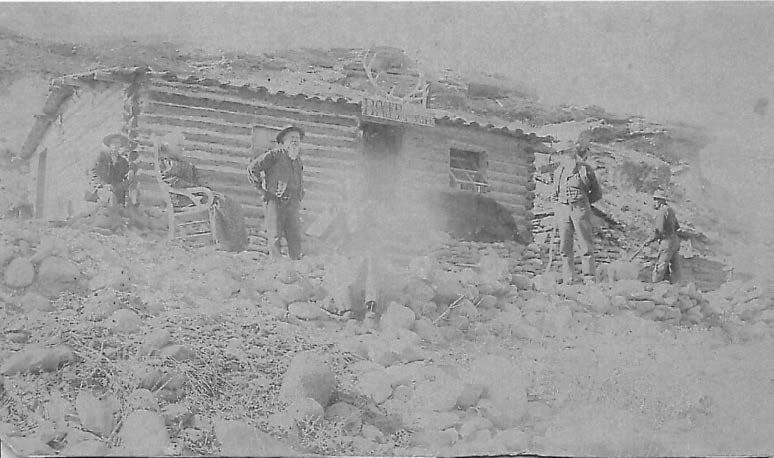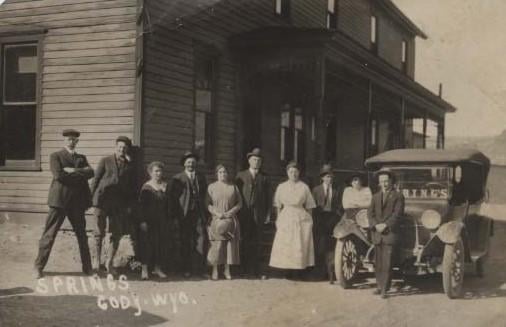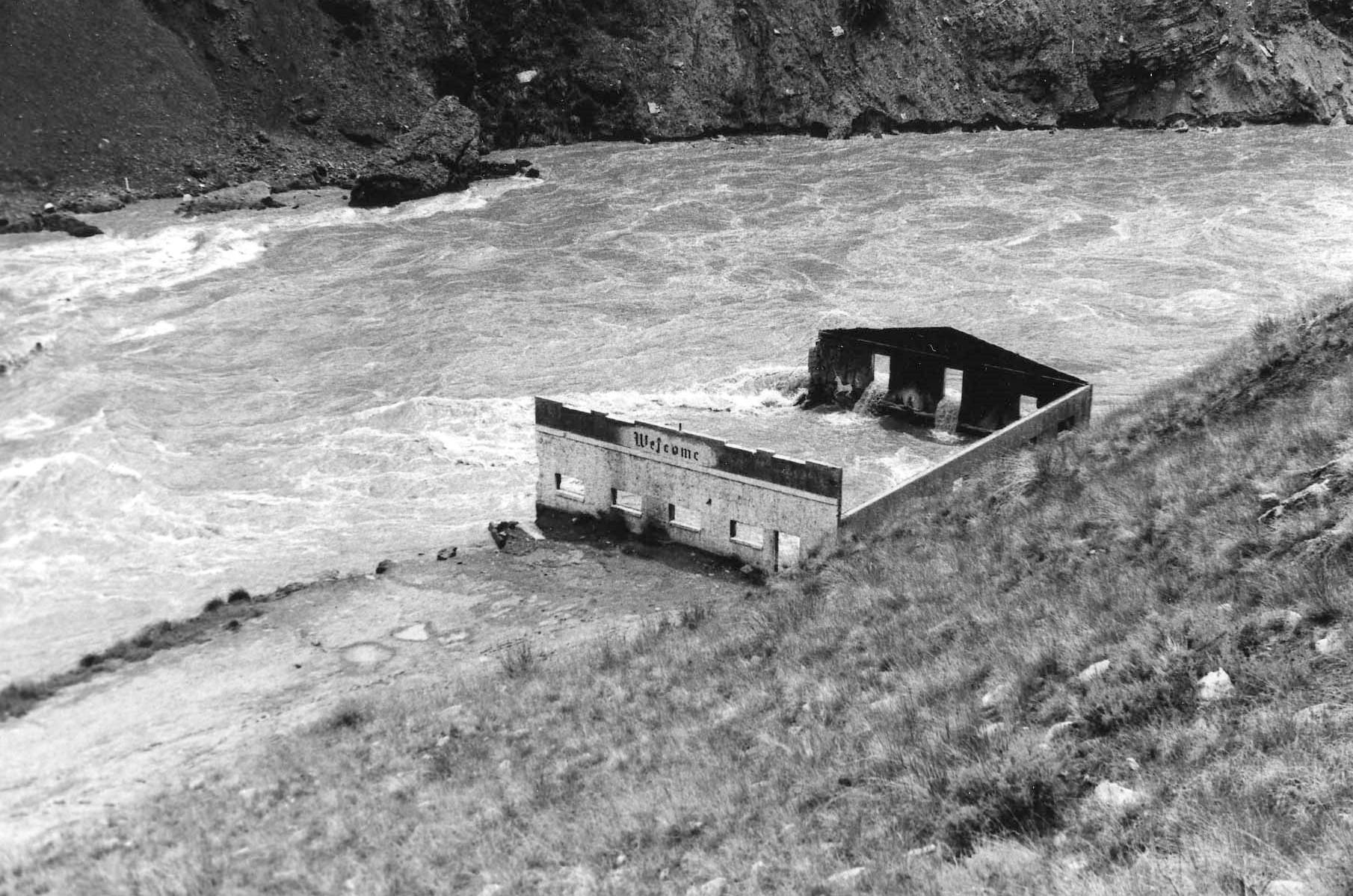Two Heritage Museum Volunteers Have Ties to Demaris Springs
In a museum, sometimes the people behind the front desk are a wealth of information, even more so than the exhibits themselves. Here at the Cody Heritage Museum, two of our regular volunteers, Terry Bartlett and Joni Ratliff, have fascinating family stories going back more than a century. Their local roots are deep. Both have ancestors who settled beside the hot springs in the Shoshone River Canyon in Cody’s early days.
Terry Bartlett’s Family
Terry Bartlett’s ancestors arrived before the town of Cody existed, and when white settlers were just beginning to arrive in the area. Previously, in 1868, the Treaty of Fort Laramie had reserved the Bighorn Basin for the Apsáalooke Crow Nation; white settlement was not legally allowed. But following the Battle of Little Bighorn in 1876, even though the Apsáalooke (Crow) were allies of the United States and fought on the side of the U.S. Cavalry during the Battle of Little Bighorn, their loyalty was not rewarded. In 1877, an Act of Congress undermined the treaty. The Crow were pressured to cede the entire Bighorn Basin to the United States, under threat that military protection and food rations would be removed.
Terry’s great-great-grandparents, Austin and Nancy Edick, arrived in the area just after the Bighorn Basin opened to white settlement. According to Terry, the couple first settled in Red Lodge as squatters, but when someone legally purchased the land where they had built a cabin, they were forced to move. Their new destination was sixty miles south, in the Wyoming Territory, where they heard that a hot spring in the Stinking Water Canyon could be good for their rheumatism. In the early 1880s, no railroad line provided access to the future site of Cody, so the Edicks probably traveled by horse and wagon from Red Lodge to the Stinking Water River. Deep inside the canyon west of today’s Cody, on the rocky shore beside the river, they built a log cabin. It was well-constructed, with hewn logs insulated with chinking, and an elk antler decorating the roof over the front door. At least one of the two windows opened on a hinge.

Edick Cabin in Shoshone River Canyon, 1886. Photo courtesy of Park County Archives.
When this photo was taken in 1886, the Edicks had settled at what would soon be known as “DeMaris Hot Springs,” but the Edicks were technically squatters again. They soon settled in another well-built cabin down the South Fork.

After Charles DeMaris purchased the land including the hot springs in 1886, the Edicks relocated to the South Fork of the Shoshone and built a new cabin. Photo Courtesy of Park County Archives.
DeMaris was a cattle rancher and eventually purchased 160 acres west of the future site of Cody. He and his wife Nellie built their new home near the Edicks log cabin and developed the hot springs into a resort. In 1907, the DeMaris family also built a “town home” at 1092 Sheridan Avenue in downtown Cody, which now houses the Cody Heritage Museum.
Sixty years later, the Edicks great-great-grandson, Terry Bartlett, was born in 1946. He has lived in Cody most of his life, is a Cody High School graduate, and developed the first swimming program for Cody High School. When he started coaching, the team practiced at an outdoor pool beside the Cody Auditorium.
Terry explained, “Because of that swim team, Paul Stock built a pool on the school grounds just west of the gymnasium.” When the pool was complete, Terry became the first head coach of the Cody High School swim team in November 1968.
For decades, Terry coached swimming, diving, wrestling, tennis, and football. Like his pioneer ancestors, Terry has a heart for adventure. He once swam the cold, rushing waters of the North Fork of the Shoshone River in a wetsuit, swim cap, and goggles. In stages, he eventually swam over 40 miles from Pahaska to Buffalo Bill Reservoir. Terry has volunteered at the CHM since its beginning in 2018.

The Canyon Hotel at DeMaris Hot Springs. Photo courtesy of Park County Archives.
Joni Ratliff’s Family
Another beloved Cody Heritage Museum volunteer is Joni Ratliff. Joni’s family also has ties to the hot springs in the Shoshone River Canyon. Joni’s mother Hilda (Knight) moved to Cody with her parents in 1915, when she was just an infant. Then, in the 1940s, Hilda and her husband Jimmie Ratliff ran the Bronze Boot Supper Club and Lounge, a popular steak house that once stood beside DeMaris Hot Springs, down inside the Shoshone River Canyon. Hilda and Jimmie bought the business from Hilda’s brother and sister-in-law, Nick and Fay Knight, who in turn had purchased the property from the DeMaris family.
Decades earlier, Charles and Nellie DeMaris had constructed a building at the hot spring in 1901, which later became the “Canyon Hotel.” The business was given a new name in April 1946, after a close family friend named Fritz Truan was killed while serving with the US Marines Corps at Iwo Jima. Truan had been a world champion bronc rider and a friend of Joni’s uncle, Nick. Truan’s mother gifted one of Truan’s bronzed boots to Nick Knight, and he named the restaurant the “Bronze Boot” in honor of his friend. Over the years, celebrities, actors, and musicians visited the Bronze Boot, including Roy Rogers.

Hilda Ratliff poses with Bronze Boot guest, Roy Rogers. Photo courtesy of Joni Ratliff.
Nine years after her parents bought the Bronze Boot Restaurant in 1947, Joni Ratliff was born in Cody in 1956. She graduated from Cody High School and then attended college in Powell and in Greely, Colorado. After a career as a special education teacher in Colorado, Joni returned to Cody and now serves on the Board of Directors for the Cody Heritage Museum. She donated Fritz Truan’s bronze boot to the museum, as well as the restaurant’s original cash register, and these items are now on display in our “World War Two Era” case.

Fritz Truan’s Bronze Boot, and the original cash register for the Bronze Boot Supper Club and Lounge, on display at the Cody Heritage Museum. Photo courtesy of Park County Archives.
Joni remembers that the resort at DeMaris Hot Springs washed away in several stages, often due to high water on the Shoshone River in the spring. The original dam was only 325 feet high, and water from Buffalo Bill Reservoir sometimes flooded over the top of the dam before the 1990s. In decades past, locals had access to the hot springs via a wooden bridge near today’s boat launch behind Old Trail Town. Today, the hot springs are privately owned and closed to the public. All that remains of the original resort is the concrete pool and a small building.

Spring floods gradually destroyed the walls of the DeMaris Hot Springs bathhouse. Photo courtesy of Park County Archives.
When the access bridge across the river was destroyed, the Bronze Boot Supper Club moved up to the shelf above the river, at the current site of The Terrace. It stayed in business until 1978.
Please stop by the Cody Heritage Museum this summer to visit with Terry or Joni, or any of our other amazing volunteers.
[Editor’s Note: There is no current access to Demaris Hot Springs as it is on private property]

Amy Hoffman
Curatorial Assistant
Cody Heritage Museum
The Cody Heritage Museum focuses on local Cody history -- and accepts family contributions of artifacts and objects that fit the areas of focus for the museum. Get in touch if you can contribute our growing collection.
